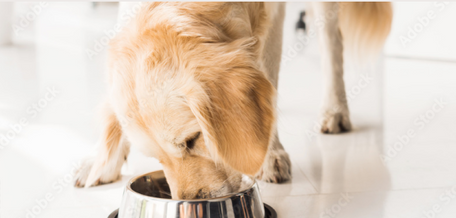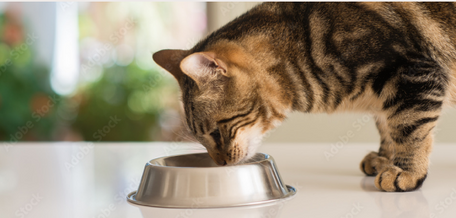
My Pet is a Picky Eater
Amongst the ever-growing list of diseases that plague our pets, there is one that seems to be more widespread than any other, one that plagues experts and novices alike. This health condition has spawned countless solution products, influenced marketing on a mass scale, and left many pet parents dejected and desperate. This health condition, this disease, is pickiness.
We’ve all been there – eagerly, nervously, setting down a bowl of new food, anxious for the verdict – like our pet is Gordon Ramsay and the new dish is our offering on MasterChef. Gordon sniffs the dish, points his nose in the air, and struts away, leaving us to dejectedly crawl back to whatever food Precious Chef usually eats. This is frustrating for everyone, especially those trying to deal with a health condition or upgrade to a raw food diet from kibble. Switching could save their pets’ life, but what is there to do? The pet won’t eat it.

What if there was a new food that could entice even the most stubborn pallet? A magic cocktail of deliciousness that no pet could refuse? Instant delight! Instant success! Just add this remedy, this elixir, this fairy dust, and your pet will be dancing circles around the food bowl! Never worry about pickiness again! This new food solves all your problems!
Unfortunately, this “new food” does not exist. There is no “easy cure” if your pet is a picky eater, and never will be. This is because pickiness is a disease that is related to an imbalance in the gut microbiome and is reinforced by lifestyle choices cultivated by generations of poor diet and breeding practices. Many articles and blogs are dedicated to overcoming pickiness or transitioning despite pickiness, but there are precious few that detail why we have pickiness in the first place. There must be a cause related to our comfortable lifestyle – you don’t see wild dogs or wolves turning their nose up at, well, anything – and to the conditions in the gut of the modern house pet.
Feeding History of Cats and Dogs
There must be a cause related to our comfortable lifestyle – you don’t see wild dogs or wolves turning their nose up at, well, anything – and to the conditions in the gut of the modern house pet. I say “modern” here because pickiness is a very modern condition. Throughout history, dogs and cats have been scavengers hunter-gatherers, with dogs typically gorging and fasting and cats hunting small meals throughout the day. Back then, you had to eat what was available because it was impossible to say when the next meal would be. “Scheduled mealtime” is a relatively new concept, only really emerging within the last hundred years or so.
This is also true of commercial “complete and balanced” foods. Wild dogs and cats achieve balance the same way humans do – over time, rather than on a meal-to-meal basis. Even pets used to rarely eat the same thing every day, living primarily on table scraps, trash, and whatever small animals they could catch. It wasn’t until 1956 when the first kibble was released as a convenience product, that animals began free feeding and exercising less. This ushered in an age of degenerative diseases and perceived pickiness, problems that are perpetuated by the food and health industries alike. Modern diseases circle around what and how our pets are eating.

What Do We Know About Pickiness?
As our understanding of the gut microbiome grows, so does our knowledge of the “gut-brain connection”. Essentially, bacteria in the gut send signals to the brain that control a massive amount of things, including food preferences. Different bacteria feed on other foods and will cultivate cravings based on what they eat. For example, the bacteria that aid in the digestion of carbohydrates are different from those that aid in digesting fats. Supporting a diverse culture in the gut allows each of these (and the thousands of other types of bacteria) to coexist beneficially. However, if one is fed significantly more than the other, it will grow much stronger, multiplying more rapidly and controlling more functions. This state of imbalance is where many of our pets find themselves after a lifetime of eating the same thing at the same time every day, mainly if the diet is highly processed.
This is why just throwing new foods at a picky dog or cat and hoping that they eat them will not work. It is also why dogs and cats often “suddenly stop eating” food after enjoying it for a couple of weeks – their gut bacteria are telling them to eat what feeds them. There is no “cure” for pickiness – no magic dust or complicated formula, no product that will remove all your problems.

My Tips For A Dog’s Pickiness
However, there is a simple, cheap, and effective solution if your pet is a picky eater. No one can sell it to you, because you have to achieve it yourself. The solution is patience. By simply waiting it out, remaining steadfast in your decision to switch foods, you are allowing biology to do the work for you. Without the food they need, the out-of-control bacteria will begin to die, eventually coming back into alignment with the rest of the system. Your dog will no longer have bacteria-inspired resentment towards new foods, and you can begin the process of building up a strong, diverse bacteria culture in their gut. To help with this, we recommend foods that will strengthen the gut wall and encourage healthy microbial inoculation, like bone broth and raw goat milk!
This method works very well with dogs, but not with cats! While dogs are optimized for fasting, cats are not – a prolonged fast can cause the liver to be overwhelmed by the rapid breakdown of fatty tissue. Cats’ metabolisms don’t down-regulate during a fast, so their excess fat begins to break down very quickly, causing liver failure within a few days. For this reason, it is not advised to let your cat fast for longer than one day leading up to a transition. (This condition, like most health conditions, is exacerbated by obesity and lack of exercise)

My Tips for a Cat’s Pickiness
So what then? If the cat doesn’t eat the new food by day two, do you have to just give up? This story, involving one of my own cats, offers an alternative method of introduction that works for cats and also for particularly stubborn dogs.
A few years ago, one of my cats was dealing with a bout of pickiness. Since infancy, this cat had been raw fed and was on a constantly rotating diet, getting as many as five different proteins in various recipes every week (honestly, this cat ate better than me!). Imagine my surprise when I brought home some raw green tripe, and she refused it! I tried everything I knew at the time to encourage her – mixing it with food she liked, adding milk and broth, serving it at various temperatures, and she still refused to eat it. After a week of this, I had just about decided that it wasn’t worth it, but because of the insane health benefits of green tripe, I tried one last Hail Mary – every day, I would add a crumb of tripe underneath her other food – such a small portion that she couldn’t tell it was there. By increasing the amount incrementally every few days, I was eventually able to get my cat to eat green tripe plain, and it became one of her favorite foods.
This is a different situation than one in which your pet has a bacteria imbalance – my cat was simply afraid to try this new smelly food because she didn’t know what it was. Cats are commonly referred to as imprint feeders – as kittens, they learn to categorize certain tastes, textures, and smells as “food” and everything else as “not food”. Since my cat had never been presented with tripe before, she didn’t know that it was edible. A very intentional, very gradual introduction phase can overcome this barrier! Keep in mind, you may have to do this several times – every new food may present a challenge for your cat. However, we believe that the benefits of a diverse and thriving gut microbiome are worth it!
Summary
In summary, dogs and cats are complex creatures! Learning how to get on their level and work with them in ways they understand is essential to overcoming behavior diseases like pickiness. Hopefully, this article helps get you and your pet started down the path towards optimal health! As always, contact us if you have questions! We are more than happy to help where we can. Thanks!




















